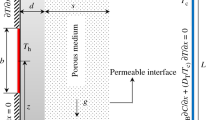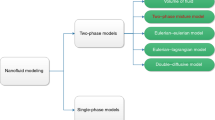Abstract
In this contribution, free convection attributes of a water-based nanofluid containing CuO nanoparticles within a perturbed cavity filled by porous medium are examined using the two-phase mixture model. The simulations are conducted at Rayleigh numbers of 103–106, Darcy numbers of 0–60, and nanoparticle concentrations of 0–3%. Based on the results, the Nusselt number enhances by increasing the concentration, and it is greater in the perturbed region compared with the other areas. At the low Rayleigh numbers, the isotherms are rather parallel to each other, while this pattern is disturbed with the Rayleigh number increment because of the buoyancy force augmentation. The maximum horizontal velocity in the enclosure increases from 0.00012 to 0.006 m/s with the increment of the Rayleigh number from 103 to 106. Moreover, the isotherms are closer to each other in the vicinity of the perturbed side. The Nusselt number significantly reduces with increase of the Darcy number from 0 to 20, while it slightly increases with increment of the Darcy number from 20 to 60. In addition, more rotational cores are formed in the vicinity of the perturbed side in the cases with the porous medium. According to the signal to noise analysis, the porosity has more significant effect on the Nusselt number compared to the effect of the Rayleigh number and nanoparticle fraction.












Similar content being viewed by others
References
Giwa SO, Sharifpur M, Ahmadi MH, Meyer JP (2020) A review of magnetic field influence on natural convection heat transfer performance of nanofluids in square cavities. J Therm Anal Calorim. https://doi.org/10.1007/s10973-020-09832-3
Mahmoodi M (2011) Numerical simulation of free convection of a nanofluid in L-shaped cavities. Int J Therm Sci 50:1731–1740. https://doi.org/10.1016/j.ijthermalsci.2011.04.009
Javadi MA, Hoseinzadeh S, Ghasemiasl R, Heyns PS, Chamkha AJ (2020) Sensitivity analysis of combined cycle parameters on exergy, economic, and environmental of a power plant. J Therm Anal Calorim 139:519–525. https://doi.org/10.1007/s10973-019-08399-y
Ganvir RB, Walke PV, Kriplani VM (2016) Heat transfer characteristics in nanofluid—a review. Renew Sustain Energy Rev 75:451–460. https://doi.org/10.1016/j.rser.2016.11.010
Tian XX, Kalbasi R, Qi C, Karimipour A, Huang HL (2020) Efficacy of hybrid nano-powder presence on the thermal conductivity of the engine oil: an experimental study. Powder Technol 369:261–269
Dehghan M, Ebrahimi F, Vinyas M (2019) Wave dispersion characteristics of fluid-conveying magneto-electro-elastic nanotubes. Eng Comput. https://doi.org/10.1007/s00366-019-00790-5
Roohi R, Heydari MH, Bavi O et al (2019) Chebyshev polynomials for generalized Couette flow of fractional Jeffrey nanofluid subjected to several thermochemical effects. Eng Comput. https://doi.org/10.1007/s00366-019-00843-9
Çelik İ (2019) Squeezing flow of nanofluids of Cu–water and kerosene between two parallel plates by Gegenbauer Wavelet Collocation method. Eng Comput. https://doi.org/10.1007/s00366-019-00821-1
Wang G, Qi C, Liu M, Li C, Yan Y, Liang L (2019) Effect of corrugation pitch on thermo-hydraulic performance of nanofluids in corrugated tubes of heat exchanger system based on exergy efficiency. Energy Convers Manag 186:51–65
Asadi A, Bakhtiyari AN, Alarifi IM (2020) Predictability evaluation of support vector regression methods for thermophysical properties, heat transfer performance, and pumping power estimation of MWCNT/ZnO–engine oil hybrid nanofluid. Eng Comput. https://doi.org/10.1007/s00366-020-01038-3
Esfe MH, Esfandeh S, Alirezaie A (2018) A novel experimental investigation on the effect of nanoparticles composition on the rheological behavior of nano-hybrids. J Mol Liq 269:933–939
Esfe MH et al (2018) Experimental study for developing an accurate model to predict viscosity of CuO–ethylene glycol nanofluid using genetic algorithm based neural network. Powder Technol 338:383–390
Esfe MH, Rostamian H, Sarlak MR, Rejvani M, Alirezaie A (2017) Rheological behavior characteristics of TiO2-MWCNT/10w40 hybrid nano-oil affected by temperature, concentration and shear rate: an experimental study and a neural network simulating. Physica E 94:231–240
Nadooshan AA, Esfe MH, Afrand M (2018) Prediction of rheological behavior of SiO2-MWCNTs/10W40 hybrid nanolubricant by designing neural network. J Therm Anal Calorim 131(3):2741–2748
Esfe MH, Bahiraei M, Hajmohammad MH, Afrand M (2017) Rheological characteristics of MgO/oil nanolubricants: experimental study and neural network modeling. Int Commun Heat Mass Transfer 86:245–252
Esfe MH, Saedodin S, Rejvani M, Shahram J (2017) Experimental investigation, model development and sensitivity analysis of rheological behavior of ZnO/10W40 nanolubricants for automotive applications. Physica E 90:194–203
Esfe MH, Rostamian H, Esfandeh S, Afrand M (2018) Modeling and prediction of rheological behavior of Al2O3-MWCNT/5W50 hybrid nano-lubricant by artificial neural network using experimental data. Physica A 510:625–634
Dehkordi RA, Esfe MH, Afrand M (2017) Effects of functionalized single walled carbon nanotubes on thermal performance of antifreeze: an experimental study on thermal conductivity. Appl Therm Eng 120:358–366
Esfe MH, Saedodin S, Biglari M, Rostamian H (2015) Experimental investigation of thermal conductivity of CNTs-Al2O3/water: a statistical approach. Int Commun Heat Mass Transfer 69:29–33
Esfe MH, Arani AAA, Badi RS, Rejvani M (2018) ANN modeling, cost performance and sensitivity analyzing of thermal conductivity of DWCNT–SiO2/EG hybrid nanofluid for higher heat transfer. J Therm Anal Calorim 131(3):2381–2393
Esfe MH, Rostamian H, Shabani-Samghabadi A, Arani AAA (2017) Application of three-level general factorial design approach for thermal conductivity of MgO/water nanofluids. Appl Therm Eng 127:1194–1199
Esfe MH, Hajmohammad MH, Razi P, Ahangar MRH, Arani AAA (2016) The optimization of viscosity and thermal conductivity in hybrid nanofluids prepared with magnetic nanocomposite of nanodiamond cobalt-oxide (ND-Co3O4) using NSGA-II and RSM. Int Commun Heat Mass Transfer 79:128–134
Rabiei S et al (2020) Thermal and hydraulic characteristics of a hybrid nanofluid containing graphene sheets decorated with platinum through a new wavy cylindrical microchannel. Appl Therm Eng 181:115981
Esfe MH et al (2020) Application of conventional and hybrid nanofluids in different machining processes: a critical review. Adv Coll Interface Sci 282:102199
Esfe MH, Wongwises S, Naderi A, Asadi A, Safaei MR, Rostamian H, Karimipour A (2015) Thermal conductivity of Cu/TiO2–water/EG hybrid nanofluid: experimental data and modeling using artificial neural network and correlation. Int Commun Heat Mass Transfer 66:100–104
Esfe MH, Arani AAA, Rezaie M, Yan WM, Karimipour A (2015) Experimental determination of thermal conductivity and dynamic viscosity of Ag–MgO/water hybrid nanofluid. Int Commun Heat Mass Transfer 66:189–195
Esfe MH, Yan WM, Akbari M, Karimipour A, Hassani M (2015) Experimental study on thermal conductivity of DWCNT-ZnO/water-EG nanofluids. Int Commun Heat Mass Transfer 68:248–251
Esfe MH, Esfandeh S, Arani AAA (2019) Proposing a modified engine oil to reduce cold engine start damages and increase safety in high temperature operating conditions. Powder Technol 355:251–263
Esfe MH, Arani AAA, Esfandeh S, Afrand M (2019) Proposing new hybrid nano-engine oil for lubrication of internal combustion engines: Preventing cold start engine damages and saving energy. Energy 170:228–238
Esfe MH, Arani AAA, Esfandeh S (2018) Improving engine oil lubrication in light-duty vehicles by using of dispersing MWCNT and ZnO nanoparticles in 5W50 as viscosity index improvers (VII). Appl Therm Eng 143:493–506
Esfe MH, Hosseinizadeh E, Esfandeh S (2020) Flooding numerical simulation of heterogeneous oil reservoir using different nanoscale colloidal solutions. J Mol Liq 302:111972
Esfe MH, Esfandeh S (2020) 3D numerical simulation of the enhanced oil recovery process using nanoscale colloidal solution flooding. J Mol Liq 301:112094
Esfe MH, Esfandeh S, Hosseinizadeh E (2020) Nanofluid flooding for enhanced oil recovery in a heterogeneous two-dimensional anticline geometry. Int Commun Heat Mass Transfer 118:104810
Esfe MH, Esfandeh S, Hosseinizadeh E (2020) Nanofluid flooding in a randomized heterogeneous porous media and investigating the effect of capillary pressure and diffusion on oil recovery factor. J Mol Liq 113646
Qi C, Liang L, Rao Z (2016) Study on the flow and heat transfer of liquid metal based nanofluid with different nanoparticle radiuses using two-phase lattice Boltzmann method. Int J Heat Mass Transf 94:316–326
Xu X, Qi C, Shafee A, Vuong BX (2020) Heat transfer and irreversibility analysis of magnetic nanomaterial within corrugated enclosure. Int Commun Heat Mass Transfer 116:104688
Qi C, Tang J, Ding Z, Yan Y, Guo L, Ma Y (2019) Effects of rotation angle and metal foam on natural convection of nanofluids in a cavity under an adjustable magnetic field. Int Commun Heat Mass Transfer 109:104349
Matin MH, Pop I (2013) Natural convection flow and heat transfer in an eccentric annulus filled by Copper nanofluid. Int J Heat Mass Transf 61:353–364
Parvin S, Nasrin R, Alim MA, Hossain NF, Chamkha AJ (2012) Thermal conductivity variation on natural convection flow of water–alumina nanofluid in an annulus. Int J Heat Mass Transf 55(19–20):5268–5274
Nemati H, Farhadi M, Sedighi K, Ashorynejad HR, Fattahi E (2012) Magnetic field effects on natural convection flow of nanofluid in a rectangular cavity using the Lattice Boltzmann model. Sci Iran. 19:303–310. https://doi.org/10.1016/j.scient.2012.02.016
Sheikholeslami M, Ganji DD (2014) Entropy generation of nanofluid in presence of magnetic field using Lattice Boltzmann Method. Phys A Stat Mech Its Appl. 417:273–286. https://doi.org/10.1016/j.physa.2014.09.053
Hemmat Esfe M, Arani AAA, Yan WM, Ehteram H, Aghaie A, Afrand M (2016) Natural convection in a trapezoidal enclosure filled with carbon nanotube–EG–water nanofluid. Int J Heat Mass Transf 92:76–82
Mahmoudi AH, Abu-Nada E (2013) Combined effect of magnetic field and nanofluid variable properties on heat transfer enhancement in natural convection. Numer Heat Transf Part A Appl. 63:452–472. https://doi.org/10.1080/10407782.2013.733182
Miroshnichenko IV, Sheremet MA, Pop I (2017) Natural convection in a trapezoidal cavity filled with a micropolar fluid under the effect of a local heat source. Int J Mech Sci 120:182–189
Hossain MS, Alim MA (2014) MHD free convection within trapezoidal cavity with nonuniformly heated bottom wall. Int J Heat Mass Transf 69:327–336
Bondareva NS, Sheremet MA, Oztop HF, Abu-Hamdeh N (2017) Entropy generation due to natural convection of a nanofluid in a partially open triangular cavity. Adv Powder Technol 28(1):244–255
Das D, Basak T (2017) Role of distributed/discrete solar heaters for the entropy generation studies in the square and triangular cavities during natural convection. Appl Therm Eng 113:1514–1535
Kefayati GR, Hosseinizadeh SF, Gorji M, Sajjadi H (2011) Lattice Boltzmann simulation of natural convection in tall enclosures using water/SiO2 nanofluid. Int Commun Heat Mass Transfer 38(6):798–805
Bouhalleb M, Abbassi H (2014) Natural convection of nanofluids in enclosures with low aspect ratios. Int J Hydrogen Energy 39(27):15275–15286
Afrand M, Rostami S, Akbari M, Wongwises S, Esfe MH, Karimipour A (2015) Effect of induced electric field on magneto-natural convection in a vertical cylindrical annulus filled with liquid potassium. Int J Heat Mass Transf 90:418–426
Afrand M, Sina N, Teimouri H, Mazaheri A, Safaei MR, Esfe MH, Toghraie D (2015) Effect of magnetic field on free convection in inclined cylindrical annulus containing molten potassium. Int J Appl Mech 7(04):1550052
Sheikholeslami M, Ganji DD, Moradi R (2017) Forced convection in existence of Lorentz forces in a porous cavity with hot circular obstacle using nanofluid via Lattice Boltzmann method. J Mol Liq 246:103–111
Esfe MH (2020) Using a two-phase method for numerical natural convection simulation in a cavity containing multiwalled carbon nanotube/water. J Thermal Anal Calorim. https://doi.org/10.1007/s10973-020-09950-y
Lin Y, Zheng L, Zhang X (2014) Radiation effects on Marangoni convection flow and heat transfer in pseudo-plastic non-Newtonian nanofluids with variable thermal conductivity. Int J Heat Mass Transf 77:708–716
Keshavarz Moraveji M, Barzegarian R, Bahiraei M, Barzegarian M, Aloueyan A, Wongwises S (2018) Numerical evaluation on thermal–hydraulic characteristics of dilute heat-dissipating nanofluids flow in microchannels. J Therm Anal Calorim. https://doi.org/10.1007/s10973-018-7181-3
Nithiarasu P, Seetharamu KN, Sundararajan T (1997) Natural convective heat transfer in a fluid saturated variable porosity medium. Int J Heat Mass Transf 40:3955–3967
Manninen M, Taivassalo V, Kallio S (1996) On the mixture model for multiphase flow. Technical Research Centre of Finland: VTT Publications, Espoo
Schiller L, Naumann A (1935) A drag coefficient correlation. VDI Zeitung 77:318–320
Erturk E, Corke TC, Gokcol C (2005) Numerical solutions of 2-D steady incompressible driven cavity flow at high Reynolds numbers. Int J Numer Meth Fluids 48:747–774
Daneshvar N et al (2007) Biodegradation of dye solution containing Malachite Green: optimization of effective parameters using Taguchi method. J Hazard Mater 143:214–219
Author information
Authors and Affiliations
Corresponding author
Ethics declarations
Conflict of interest
The authors declare that they have no conflict of interest.
Additional information
Publisher's Note
Springer Nature remains neutral with regard to jurisdictional claims in published maps and institutional affiliations.
Rights and permissions
About this article
Cite this article
Hemmat Esfe, M., Esfandeh, S. & Bahiraei, M. A two-phase simulation for investigating natural convection characteristics of nanofluid inside a perturbed enclosure filled with porous medium. Engineering with Computers 38, 2451–2468 (2022). https://doi.org/10.1007/s00366-020-01204-7
Received:
Accepted:
Published:
Issue Date:
DOI: https://doi.org/10.1007/s00366-020-01204-7




